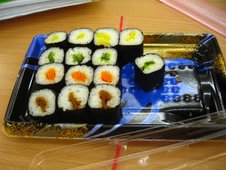Traditional Japanse cooking does not use an oven. For this reason, most Japanese houses and apartments (including mine) do not have an oven. This has been a difficult adjustment for me.
Certain ingredients common in many cooking styles around the world are not used in Japanese cooking and thus not available anywhere in Japan. The one I have had to omit the most in all the non-Japanese recipes I have made here is coriander (or cilantro). It is available dried at larger grocery stores and foreign import stores but I have yet to see it fresh anywhere in the country.
Abura Age (あぶらあご): Deep-fried tofu pockets that are very versatile. They can be boiled in soy sauce and sugar and filled with sushi rice to make inari sushi (see inari age below). They can also be added to soups and stews and almost anything else for a boost of deep-fried protein. They should be rinced in boiling water before use to make them a bit less oily. Age (pronounced ah-gay) means deep-fried in Japanese.
Daikon (だいこん): Tranlated as long radish, daikon is a huge white root with a green top. Grated, it is often used as a garnish. It helps with digestion and so after meals, it is often eaten just boiled in a soy sauce broth. This is a tasty vegetable but I don't buy it anymore because it stinks up the fridge, especially if refrigerated cooked.
Gobo (ごぼ): Translated as burdock root, this is a root that grows in many countries but is only eaten in Japan (as far as I know). You should always peel it and soak it in water for 5 minutes before cooking. I have no idea why. This vegetable is really slimy and slippery to work with when it is raw but is really tasty (and no longer slimy at all) when cooked.
Inari Age (いなり あげ): These are abura age pockets that have already been prepared for making inari by being seasoned with soy sauce and sugar in a perfect ratio. They are usually only around 100 or 200 yen for 10 and make cooking inari SO much easier. Not sure if these are available overseas.
Koji (こうじ): Soybeans (intentionally) infected with mold. It’s sold in supermarkets and looks kind of like tempeh. It’s not tempeh! It’s used in making homemade sake, mirin, and natto.
Mirin (みりん): is essentially a sweet cooking sake. It is available in the soy sauce/rice vinegar section of grocery stores in Japan and is probably available at Asian grocery stores overseas as well. It can be substituted with regular sake and a bit of sugar or just sugar and water.
Negi (ねぎ): Translated as welsh onion, negi is basically a huge scallion (or spring onion) with a stronger flavour. In size they are about halfway between a scallion and a leek but the the flavour and texture are definitely closer to scallion. It can be replaced by almost any members of the onion family.
Okara (おから): The bran of soy beans filtered out of the soy milk in the process of making tofu. It is bland but very nutrious and has the texture of desiccated coconut. You can get it from supermarkets and tofu shops. It is very cheap and I have even of stores where you get it free with purchase of tofu. Apparently it is a good base for veggieburgers.
Renkon (れんこん): Translated as lotus root, renkon is a circular root with tube-like holes inside extending the whole lenth of the root. It therefore has a very strange look when it is cut. Renkon should be boiled in water with a bit of vinegar to keep it from turning blue when you cook it. I don't really like renkon because it never really seems cooked. It is always crisp and tastes raw.
Soba (そば): This is simply buckwheat. It is most commonly seen in its noodle form which can be purchased fresh, hard, or even pre-cooked. The noodles are very tasty, healthy, cheap, and widely available. Soba can also be made into a tea (sold hot or cold), flour, etc.
Yuba(ゆば): The skin that forms on the top when boiling down soymilk. Widely available although sometimes can be expensive. Many and varied cooking applications.





